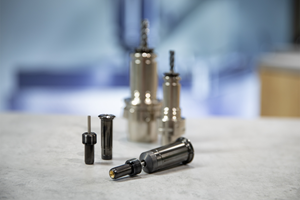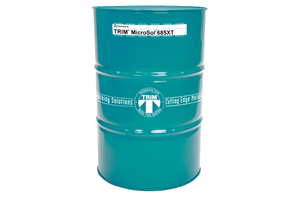Closed Loop System For High Speed Spindles
As high speed machining has become more common, machine tool spindle technology has continued to advance. Spindle lubrication has been a special area of concern, and significant improvements have been appearing steadily.
Share






As high speed machining has become more common, machine tool spindle technology has continued to advance. Spindle lubrication has been a special area of concern, and significant improvements have been appearing steadily. For example, GTI Spindle Technology (Manchester, New Hampshire) is offering an air/oil system that creates a closed loop method of delivering and recovering spindle lubrication fluid. The system, developed in conjunction with Bijur Lubricating Co. (Bennington, Vermont), overcomes one of the last drawbacks to oil-mist lubrication systems for high speed spindles on machine tools.
This recently patented equipment virtually eliminates the problem of escaping airborne oil particles from "open" oil-mist lubrication systems. Stray oil can cause slippery floors, contaminate machine coolant and waste expensive lubricant, developers claim. The new oil reclamation system, however, can be added to many existing spindles, depending on their design.
These systems inject oil directly into an air stream. The oil is not first converted to a mist. For the past several years, some new machine tools (particularly grinding machines) that use high speed spindles have begun to use the new air/oil injection method of lubricant distribution.
In this new GTI-ST/Bijur system, liquid oil is fed from a reservoir into a positive displacement pumping device and then into a mixing valve. The mixing valve mixes the liquid oil with air. The combined air and oil is fed through a small tube then through a small nozzle or orifice directly into the bearing. The bearing thus receives a metered amount of oil.
Unlike the oil-mist system, the air/oil injection system produces two distinct flows. One flow consists of oil, which can be seen moving along the inner wall of a distribution tube, providing the tube is clear. The other flow is that of air. The airflow is such that it pushes the oil along the tube rather than combining with it to form a mist or spray.
Because the system does not create a mist, no mist can escape except that which is created in the bearing itself due to turbulence. The system may use oils containing additives designed to improve bearing life. Some of these oils were not used in oil-mist units because they would not produce sufficient mist. Less escaping oil means less tramp oil contamination and a cleaner work environment.
Distribution lines can now have a much smaller diameter and be easier to route around a machine. In many cases, the volume of air required can be reduced significantly. If additional air is needed for bearing cooling or air sealing, an air bypass provides increased airflow. The quantity of oil needed to lubricate a bearing is quite small. Many oil-mist systems had a tendency to add excess oil as a safety factor to compensate for oil collecting in the distribution lines or improperly set oil feed or drip rates. This safety factor is not necessary on an air/oil system because all of the oil injected into the airflow reaches the bearing, provided that the oil is injected directly into the bearing through an orifice or nozzle inside the spindle.
However, as good as these improvements are, developers did not believe they were sufficient. Some oil could still find its way into the coolant, enter the work area, or contaminate the workpiece (a condition especially unwelcome for high speed machining applications of certain aerospace materials). The final piece of the puzzle is to collect and dispose of (or filter and re-use) the lubricating oil after it has done its job. Bijur's new reclamation system is designed to accomplish this task.
GTI is offering this system as a conversion package for existing spindles. The company has designed a complete air/oil conversion panel assembly that contains the necessary hardware items. According to the company, more than one hundred of these panels are currently operating in the United States.
When applying this panel to a machine designed to use air/oil lubrication for its spindle, GTI recommends that oil output quantity be set at 0.03 cc/3 min. This rate results in a total usage of 0.6 cc/hour, which is about one half the requirement for a typical four-bearing 35,000-rpm grinding spindle. Further, GTI recommends that 0.05 cc/3 min. be used for lubricating a spindle designed to use oil-mist lubrication. In short, air-oil injection saves from 70 to 90 percent of the oil consumed in conventional oil mist systems.
The company points out that when these recommendations are compared to quantities recommended by some machine tool builders over the past years for similar type spindles (often as much as 10-11 cc/hour), it becomes clear that far too much oil is being used.
Additional devices under development will allow reclaimed oil to form a closed system to be sent to a central sump where the oil is filtered to 5 microns or smaller and returned to the various lubrication panels for reuse, automatically.
Related Content
Jorgensen Introduces Sustainable Conveyor, Material Handling, Coolant, Filtration Solutions
IMTS 2024: Jorgensen Conveyer and Filtration Solutions announces a lineup for conveyor, material handling, coolant and filtration solutions, including the EcoFilter80 self-cleaning system, the PermaClean system and others.
Read More3 Machine Options to Aid Automation
Don’t overlook controller options, process security options and coolant handling when staring down the line items of a new machine purchase.
Read MoreRego-Fix Toolholding System Reduces Coolant Consumption
MQL PG collets are designed for machines using one-channel, internal through-spindle MQL systems.
Read MoreMaster Fluid Solutions Semisynthetic Coolant Inhibits Corrosion
Trim MicroSol 685XT is designed to provide enhanced corrosion inhibition on all ferrous and nonferrous metals.
Read MoreRead Next
AMRs Are Moving Into Manufacturing: 4 Considerations for Implementation
AMRs can provide a flexible, easy-to-use automation platform so long as manufacturers choose a suitable task and prepare their facilities.
Read MoreMachine Shop MBA
Making Chips and 91ÊÓƵÍøÕ¾ÎÛ are teaming up for a new podcast series called Machine Shop MBA—designed to help manufacturers measure their success against the industry’s best. Through the lens of the Top Shops benchmarking program, the series explores the KPIs that set high-performing shops apart, from machine utilization and first-pass yield to employee engagement and revenue per employee.
Read MoreLast Chance! 2025 Top Shops Benchmarking Survey Still Open Through April 30
Don’t miss out! 91ÊÓƵÍøÕ¾ÎÛ's Top Shops Benchmarking Survey is still open — but not for long. This is your last chance to a receive free, customized benchmarking report that includes actionable feedback across several shopfloor and business metrics.
Read More





















